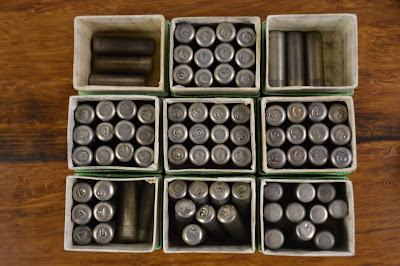This article has been edited and included in The Leadhead's Pencil Blog Volume 4; copies are available print on demand through Amazon here, and I offer an ebook version in pdf format at the Legendary Lead Company here.
If you don't want the book but you enjoy this article, please consider supporting the Blog project here.
What’s neat about this picture is that five out of these eight have come my way since August – and I haven’t had the chance to tell you about two of them yet. We’ll get to the one on the top and the one on the bottom in just a second.
Second from the top is the “Ripley” Vacumatic that turned up in an online auction just recently (http://leadheadpencils.blogspot.com/2015/12/up-close-and-personal.html):
The next two are the stars from the DC show last August – the article I posted about them, “That Kind of Show” (http://leadheadpencils.blogspot.com/2015/08/that-kind-of-show.html) became the most read article I’ve ever posted at the blog within just a few weeks:
That next one down is the one I’ve had the longest - at the time I wrote the article about it (http://leadheadpencils.blogspot.com/2013/02/don’t-be-too-quick-to-dismiss-this-one.html) I was still on the fence about whether it was a Parker concept pencil or something put together by someone with waaay to much time on their hands. The more I learn about early Parker Vacumatics and some of the weird things Parker did with the pencil line, though, the more convinced I am that this is the real thing:
On the weird scale, though, the next two probably win first prize, with their hand-engraved Vacumatic bands and Autopoint-style mechanisms (the full article can be found at http://leadheadpencils.blogspot.com/2014/09/what-might-have-been.html):
Which brings us, for your 2015 Leadhead’s finale, to these last two, both of which came my way from Dan Zazove at the Ohio Pen Show this November:
We’ll do the less obvious one first: that lower example looks like any ordinary, early production Vacumatic pencil – but the imprint sets it apart as something really special:
Before there was the Vacumatic, there was the “Vacuum Filler” . . . and before that, for just a few weeks, there was the “Golden Arrow.” The part I like best about this one is that the Arrow isn’t gold!
Last, and by far the best of the bunch, is that one with the silver nose section:
Ever since Dan Zazove co-authored the Vacumatic book, in which this pencil was pictured, it has taken on almost mythical status among we pencil collectors. The pencil, a prototype from Parker, bears no imprint, and appears to be the natural end product from the research that went into the other two Autopoint-style pencils, but in this case, the nose doesn’t come off – at least, it doesn’t willingly come off, and I’m not going to roll the dice and push it with the only example known to exist. When it accompanied Dan to the Ohio Show, the question wasn’t whether I would purchase it, but whether I would have the opportunity.
I did and I did. And when I balanced my checkbook the following month, I experienced that sinking feeling in my stomach of “why the heck am I spending all this money on this stuff?” I still have that feeling when I think about how much I paid for the stupid thing, but every time I do, all I need to do is pick it up and look at it:
That eases all of my apprehension. Whatever I paid, it was worth it.


















































